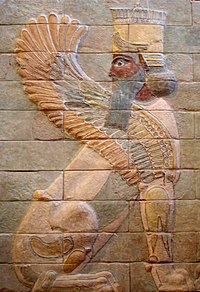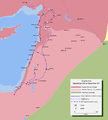Military conquests of Umar's era
This article may require cleanup to meet Wikipedia's quality standards. (May 2010) |
| Umar |
|---|
 |
|

Umar was the second Rashidun Caliph and reigned during 634–644. Umar's caliphate is notable for its vast conquests, aided by brilliant field commanders, he was able to incorporate present day Iraq, Iran, Azerbaijan, Armenia, Georgia, Syria, Jordan, Palestine, Lebanon, Egypt, and part of Afghanistan, Turkmenistan and south western Pakistan into the Caliphate. During his reign, the Byzantines lost more than three fourths of their territory and in Persia, the Sassanid Empire ceased to exist.[1]
Conquest of Eastern Roman Empire[]
Conquest of Levant (634–638)[]
Muslim forces invaded the neighboring Eastern Roman Empire in 634 soon after Conquest of Iraq in 633 during the reign of Caliph Abu Bakr. Damascus fell in September 634 and Emesa fell in March 635. In the year 635, Emperor Heraclius successfully allied with Sassanid Persian Emperor Yazdegerd III on Yazdegerd III's request to crush the Muslim power. A well coordinated plan was agreed to launch a massive counterattack against Muslims in Iraq and Syria at once so that Muslims, because of the resulted pressure may retreat back to Arabia where they may be dealt in detail later, either by invading it or by economical and trade blockage. Caliph Umar successfully tackled the alliance by putting pressure tactics on Byzantine front and deceptive tactics on Persian front and engaging Yazdegerd III into negotiations, this rendered the alliance and a would-be decisive plan abortive. The Byzantine forces were decisively defeated in Battle of Yarmouk fought in August 636, Persian army was defeated in Battle of Qadisiyyah three months later in November 636. Muslim victory pertinently ended Byzantine rule south of Anatolia, and Jerusalem fell in April 637 after a prolonged siege, Umar personally came to receive the key to the city by the Greek Orthodox patriarch, Sophronius, and was invited to offer prayers at the Church of the Holy Sepulchre. Umar chose to pray some distance from the Church, so as not to endanger its status as a Christian temple. Fifty-five years later, the Mosque of Omar was constructed on the site where he prayed.[2] After the fall of Jerusalem, Umar permitted Jews to practice their religion freely and live in Jerusalem. (See: Covenant of Umar I)
The conquest of Levant was completed in 637 after the last relentless resistance by Byzantines at Battle of Iron bridge, which resulted in Muslim occupation of Antioch, capital of eastern zone of Byzantine Empire in October 637. Emperor Heraclius attempt to capture northern Syria in 638, with the aid of Christian Arabs of Jazira, prompted Muslims to invade Jazira (Mesopotamia) in 638 and captured it securing the eastern flank of Syria from Byzantine attacks in future, soon after the occupation of Jazira, Muslim columns marched north in Anatolia, invaded and plundered Byzantine provinces of Armenia, these were however only preemptive attacks on Armenia to eliminate all Byzantine presence north of Syria, Armenia was annexed in 643 During the Conquest of Persian Empire.
These preemptive attack resulted in the creation of a buffer zone or no man's land in south-eastern Anatolia and Armenia, which would eventually evolve into the al-'Awasim. It was exactly what Umar wanted,[3] as he is quoted saying
I wish there were a wall of fire between us and the Romans, so that nor we can cross into their land neither they could in ours
The Byzantine empire already exhausted after major defeats in Yarmouk and Northern Syria was left vulnerable to Muslims' attacks and its very existence in Anatolia was threatened. Umar apparently was not interested in occupation of Anatolia, it had a cold and mountainous terrain with no economic incentives, soon after the occupation of Byzantine Armenia, the time when chaos was at its peak in Byzantium, Umar had already rejected Khalid and Abu Ubaidah's proposal of invading Anatolia. Moreover, Umar, due to his strong desire to consolidate his rule in the conquered land and owing to his non-offensive policy left the remaining Byzantine empire on its own. The situation was a stalemate, Umar had power but not desire to cross into Byzantine Empire, and Emperor Heraclius had desire but not left powerful enough to roll back his former rich provinces. For the security of northern Syria, Umar issued orders for annual raids into Byzantine territories in Anatolia and Muslims raided as far as Phrygia.
Conquest of Egypt (640–642)[]
After losing the Levant, the economic lifeline of Byzantines and Armenia, the manpower hub, Emperor Heraclius was left incapable of any military come back, he rather focused to consolidate his power in Egypt. In his visit to Syria in 637 to receive surrender of Jerusalem, Amr ibn al-Aas tried to convince Umar for the invasion of Egypt, but Umar rejected on the ground that Muslim rule in Syria was still not firm. After the great plague in 639, Umar paid a visit to Syria and was again persuaded by Amr for the invasion of Egypt. Along with various other reasons, Amr convinced Umar that Byzantine influence in Egypt is a continuous threat to Muslim rule in Palestine and that Egypt is the richest land on earth that can provide Muslims with immense wealth, economical stability and strategic location for trade with North Africa and Mediterranean. Initially hesitant for the expedition Umar rejected the proposal and is reported to have said:
Life of my one soldier is dearer to me than a million Dirham.
But eventually decided to put the matter in Majlis al Shura (parliament) in Madinah. Once approved by the parliament Umar issued orders for the invasion of Egypt in December 639 which completed in 642 at the eve of Muslim conquest of Persian highlands.
Dismissal of Khalid from army (638)[]
See: Khalid's dismissal from army
In late 638, following Khalid's invasion of Byzantine Armenia in eastern Anatolia, Khalid was dismissed from army by Umar. The exact reason remained unknown, but various scholars including Muslims and non-Muslims argue that Khalid's dismissal from army at zenith of his power was due to the fact that Muslims started having faith in Khalid's command rather than God for being victorious which worried Umar, who saw this as a threat to religious believes of Muslims which says only to rely on God. Also, a poet wrote some poetry on Khalid's bravery and Khalid being impressed, gave him some award. When Umer learned about it, he called Khalid and said,
"If you have given him money from bait Ul maal, then its corruption and if you have given him your own wealth, then it is wasteful expenditure which is a sin. In both cases, you are dismissed from your rank.
Khalid, on his return from an expedition of Amida and Edessa was charged for embezzlement and thus was dismissed from army. Khalid's removal created a strong wrath among the people on the ground that Khalid, a national hero was mistreated by the Caliph and it was unjust to remove him from the army. In addition to this some supporters of Khalid embolden him to rebel against Umar's discriminatory decision but Khalid, though more than able to rebel chose to accept the decision. On his dismissal, Khalid did not say a single word and accepted the decision of Caliph by heart. After that Khalid fought all battles of his life as a soldier. Had Khalid revolted a bloody civil war would be inevitable. Khalid visited Madinah and met Umar who is reported to have given Khalid a prestigious tribute saying:
You have achieved what no man did ever before, but verily it was through Allah's help
due to his act of dismissing Khalid, Umar was highly criticized publicly. Umar thus explained his dismissal of Khalid as:
I have not dismissed Khalid because of my anger or because of any dishonesty on his part, but because people glorified him and were misled. I feared that people would rely on him for victory. I want them to know that it is Allah who does all things; and there should be no mischief in the land.
From Madinah Khalid went to Emesa and died after less than 4 years in 642 at the eve of Muslim conquest of Persia. During Hajj of the year 642 Umar decided to reappoint Khalid to the army services, he most probably intended to have Khalid's services for the invasion of mainland Persia, like Caliph Abu Bakr did during his first foreign expedition, the conquest of Iraq by using Khalid as a guaranteed victor for Persian front to boost up moral of Muslims for further such expeditions, his abilities and military prowess could also be used this time as a sure victory moreover his presence could also boost up the morale of Muslim army invading Persia and his formidable reputation as a psychological weapon against Persians. Umar reached Madinah after Hajj only to receive the news of Khalid's death that broke like a storm over Medinah. The women took to the streets, led by the women of the Banu Makhzum (Khalid's tribe), wailing and beating their chests. Though Umar, from very first day had given orders that there would be no wailing for departed Muslims, but in this one case he made an exception.
Umar reportedly said:
Let the women of the Banu Makhzum say what they will about Abu Sulaiman (Khalid), for they do not lie, over the likes of Abu Sulaiman weep those who weep.
Umar is reported to have later regretted over his decision of dismissing Khalid from army, accepting the fact that he (Khalid) was not like as he (Umar) thought of him. On his death bed, Umar is also reported to have wished that beside Abu Ubaidah ibn al-Jarrah, if Khalid would be alive he would have appointed him his successor.
Gallery[]
Map detailing the route of Muslim's invasion of central Syria.
Map detailing the route of Khalid ibn Walid's invasion of Syria.
Map detailing the route of Muslim's invasion of northern Syria.
Map detailing the route of Muslim's invasion of Egypt.
Conquest of Sassanid Persian Empire[]
Conquest of Iraq[]

Abu Bakr became caliph in 632 and triumphed in Ridda wars thus conquering Arabia by early 633. Soon after Ridda wars Abu Bakr started a war of conquest by invading neighboring rich and fertile Iraq, a province of Sassanid Empire where its capital Ctesiphon situated. Muslims under Khalid ibn Walid captured Iraq after decisive Battle of Ullais. In June 634 Khalid was sent by Abu Bakr to Roman front in Syria to command Muslim armies in Syria. Khalid left with half of his army which left Muslim position in Iraq dangerously exposed to Persian counterattack. , Khalid's successor, evacuated Iraq and camped near Arabian Desert after Persian counterattack. Umar soon sent reinforcement, to strengthen the position in Iraq, which was finally defeated in Battle of Bridge in October 635. Emperor Yazdegerd III sought help from his Byzantine counterpart Emperor Heraclius, who married his granddaughter to Yazdegerd III, an old Roman tradition to seal the alliance. Planned to overpower Umar, their common enemy, both emperors started preparations for a massive coordinated counterattack at once on their respected front to crush the threat in Arabia once for good. This alliance resulted in a bloody year of 636 in which Battle of Yarmouk in Syria and Battle of Qadisiyyah in Iraq resulted in decisive Muslim victory. Followed the victory at Qadisiyyah, Muslims captured Ctesiphon, the Sassanid Persian capital city, after two-month siege in March 637 followed by capturing of Tikrit and Mosul. Umar wanted Zagros mountains to be the frontiers between Muslims and Persians and is quoted saying
I wish that between the Suwad and the Persian hills there were walls which would prevent them from getting to us, and prevent us from getting to them. The fertile Suwad is sufficient for us; and I prefer the safety of the Muslims to the spoils of war.
Persians kept on raiding Iraq, which resulted in political instability in Iraq, as a result Muslims invaded Ahvaz in 638 which forced powerful Persian commander in chief, Hormuzan, to enter into peace negotiations with Muslims. Hormuzan agreed to accept Muslim suzerainty over Ahvaz province and agreed to rule as Muslim's vassal. Hormuzan broke peace agreement three time and each time was pardoned by Caliph Umar and the peace renewed, until the third time when on Umar's instructions his capital was besieged and he was taken prisoner and sent to Madinah to umar, where he apparently accepted Islam. He later allegedly masterminded Umar's assassination. In 641 Persians under Yazdegerd III managed to muster up a massive army to attack Iraq, this army was defeated in Battle of Nahāvand in December 642.
Conquest of mainland Persia (642-644)[]
After the battle Umar changed his policy towards Sassanid Persian Empire, Yazdegerd III, who unlike his Roman counterpart Heraclius, denied submission to Muslim supremacy in his land, was a constant threat for Caliphate, Umar decided to launch a whole scale invasion of Sassanid Persian Empire to eliminate this threat. After a devastating defeat at Nihawand, last Sassanid emperor Yazdgerd III, a man with iron nerves, was never to be able again to raise more troops to resist the mighty onslaught of Umar, it had now become a war between two rulers, Umar would follow Yazdgerd III to every corner of his empire either will kill him or will capture him, like he did with Hormuzan. Yazdgerd III would have a narrow escape at Marv when Umar's lieutenant was to capture him after Battle of Oxus river, he would save his life only by fleeing to China, far enough from reach of Umar, thus effectively ending the 400-year-old Sassanid dynasty.[4] In 642, Umar launched multi-prong expeditions into Persia, first capturing Isfahan province thus cutting off the northern province of Azerbaijan and southern province of Fars from main empire. in the second phase capturing Azerbaijan and fars thus isolating Yazdegerd III's stronghold Khurasan. The third phase further isolated Khurasan by capturing Kirman, Sistan and Makran in south while Persian Armenia in north. Fourth and last phase started in early 644 with the invasion of Khurasan. After a Decisive Battle of Oxus river, Yazdegerd III fled to central Asia and Persian Empire ceased to exist. Umar's conquest of Sassanid Persian empire by commanding the operations, while sitting about 1000 kilometer away from the battle fields, will become the greatest triumph of Umar and his strategic marvel, and marked his reputation as one of the greatest military and political genius of history, like his late cousin Khalid ibn Walid (590 – 642).[5]
See also[]
Military campaigns under Caliph Uthman
Notes[]
- ^ A Restatement of the History of Islam and Muslims on Al-Islam.org
- ^ For one version of `Umar's speech to the people after the surrender of Jerusalem, see [1].
- ^ kegri
- ^ Iranian History and Politics: The Dialectic of State and Society By Homa Katouzian, pg. 25
- ^ The Muslim Conquest of Persia By A.I. Akram. Ch:10 ISBN 0-19-597713-0,
- Military history of the Rashidun Caliphate
- Umar



